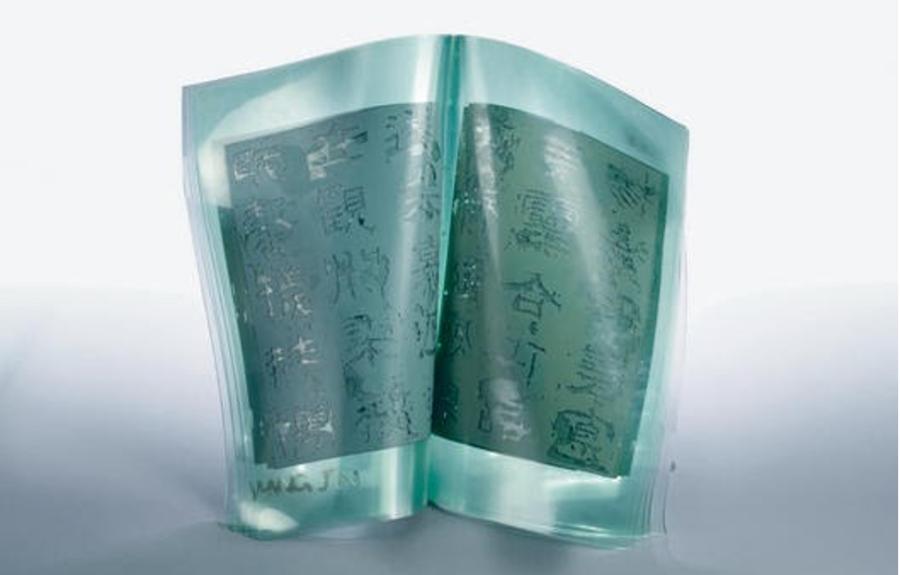
Wang Jin
New Ancient - Stele of Zhang Qian (1998)
Polyvinyl chloride
22.2 x 14.2 x 1.3 in.
In 1998, the Chinese artist Wang Jin made ten unusual books that consisted of plastic transparencies. Wang copied the stele rubbings of Zhang Qian’s calligraphy, printed them onto plastic pages, and bound them together into a single volume. The artist then installed these books in the streets of Fukuoka, Japan.
As the title suggests, New Ancient explores the entanglement of time, and of the old and the new mediums. On the one hand, this work exhibits a monumentality of the ancient. Its viewers are reminded of not only the ancient texts from the Stele of Zhang Qian, but also the bookmaking techniques that reproduced these printed images. The stone rubbing technique—which involves rubbing hard on the paper over a stone stele with pigment—has been used in China for centuries to retrieve calligraphies. In making his transparent books, the artist reanimates the same printing technique. Because the stele rubbing captures rough edges, patches, and cracks on the stone’s surface, the viewers are constantly reminded of the book’s material vulnerability. On the other hand, the plastic surface gives the book a glossy and more contemporary look. Its plastic surface, made from polyvinyl chloride (PVC) materials, laminates the stele rubbings; in doing so, it encapsulates a piece of bookmaking history. Since the plastic is a more durable material, it embalms the book in its ancient form.
When books are turned transparent, the printed words become unreadable. In narrating the history of books, the use of transparencies becomes a material metaphor. As these transparencies foreground the material substrate of the book, they also come to problematize the idea that books in themselves are a transparent carrier. And by mixing both the ancient and the new ways of bookmaking, the artist demonstrates that books have never been a stable medium. Although books are almost synonymous with the print medium in everyday language, they are—more importantly—a resilient cultural form. As the artist puts it, “Books are also extremely stubborn. Even if you don’t read them, they are still there, challenging you.”
Around the turn of the twenty-first century, numerous artists in the Sinophone world became fascinated with the visual trope of transparent books. In this presentation, I discuss how the “transparency” in these material artifacts poses a question regarding the material endurance of books. Unlike the artist's book or the book-art traditions in the Anglophone world, as I argue, these transparent books do not concern the decline of the print medium, but rather one’s personal and historical experience of censorship.
Junting Huang is a Ph.D. candidate in the Department of Comparative Literature at Cornell University. His research focuses on Sinophone literature, cinema, and media culture, Chinese diasporic culture in the Caribbean, as well as their intersections with new media studies, sound studies, and critical race theory.
